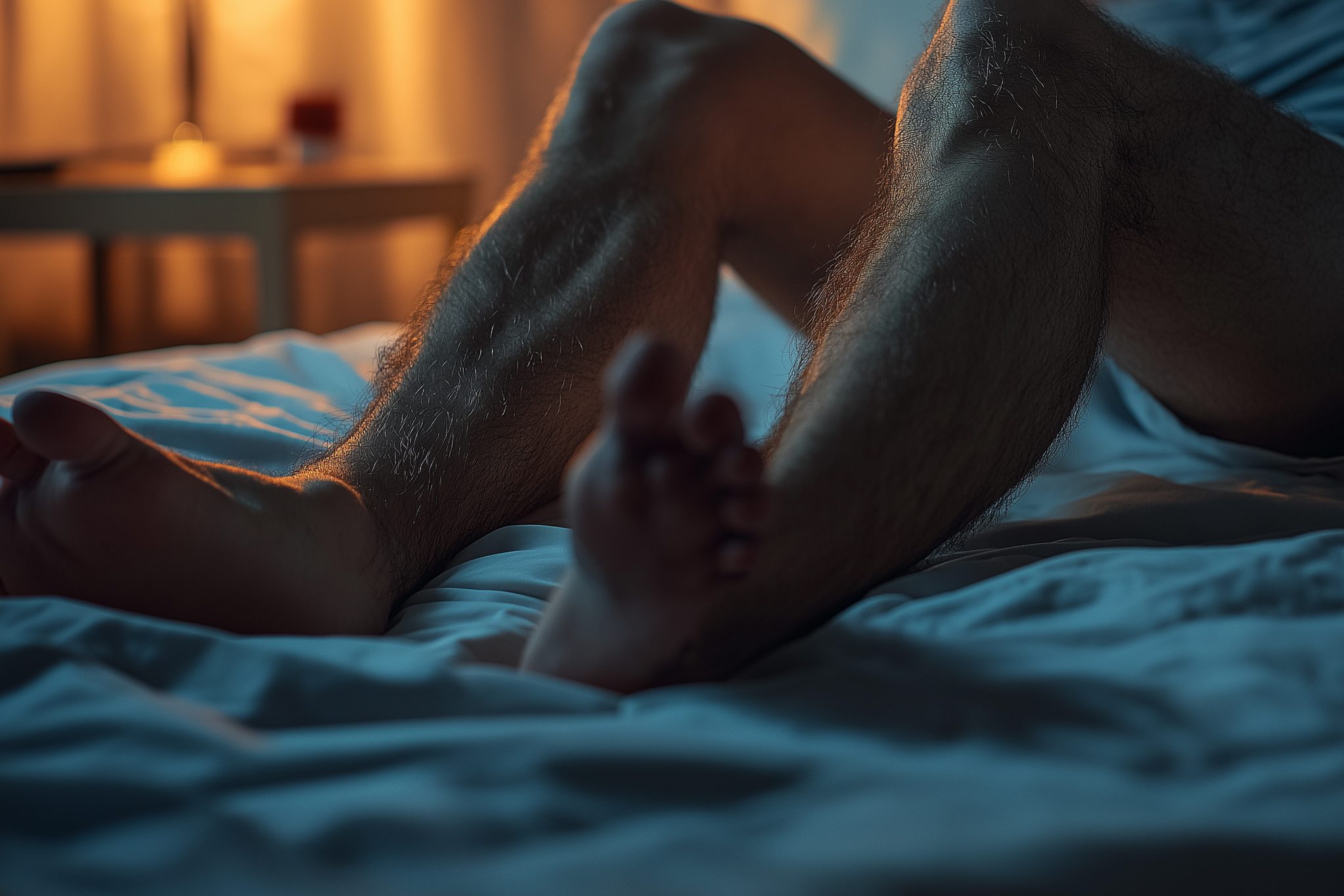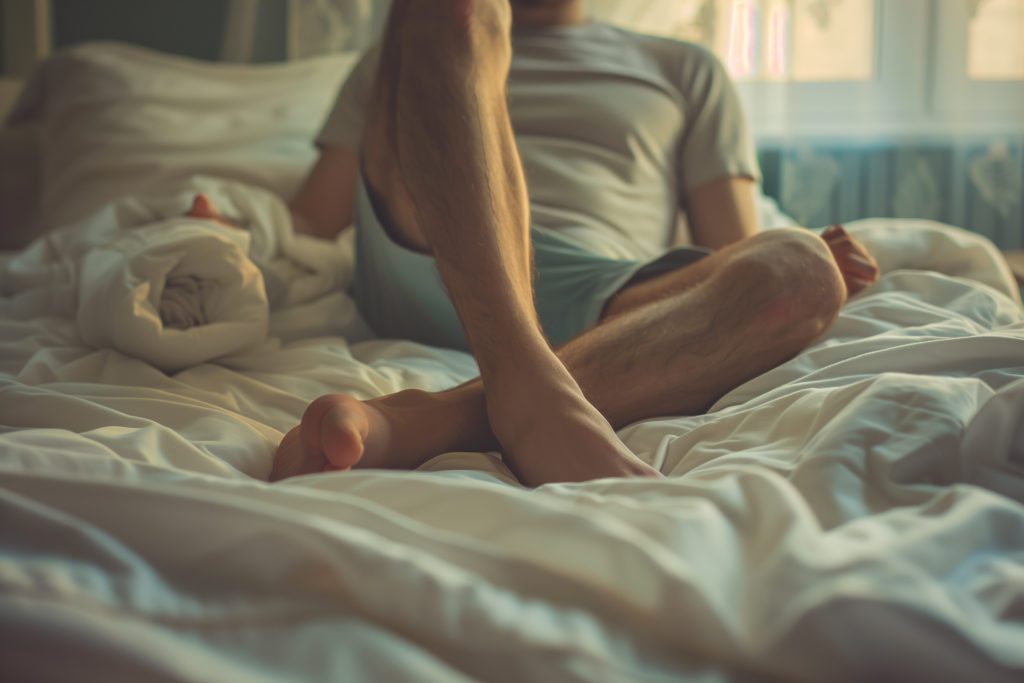
Understanding Restless Leg Syndrome: Symptoms, Causes, and Impact on Sleep
Restless leg syndrome (RLS) is a condition that causes unusual sensations in the legs and leg movements. RLS can greatly affect sleep and quality of life.

Does this sound familiar? You’ve just gotten into bed after a long day at work. But, as soon as you lie down, you experience a throbbing, itchy sensation in your legs that won’t go away unless you get up.
If this rings a bell, you may have restless leg syndrome or RLS. This is a debilitating neurological disorder that affects more than 3 million people in the United States. Also called Willis-Ekbom disease, RLS produces crawling, itchy, or achy sensations in the legs and a strong urge to move your legs just to get the feeling to stop. These symptoms occur most often while you are resting or asleep.
RLS is considered both a neurological disorder, and a sleep disorder because it affects you when you are lying down or asleep. This disorder can seriously impact sleep, leading to excessive daytime fatigue.
Who Gets RLS?
RLS affects approximately 10-15 percent of people in the United States. About three percent of people have severe symptoms. The disorder is more common among those who are:
- Women - Women or those assigned female at birth (AFAB) are twice as likely to have RLS than men.
- Middle age or later - RLS can occur at any age, but the risk increases as you get older. It also tends to be more severe in middle-aged or older adults.
- Northern European descent - RLS is more common among those of Northern European descent.
It’s believed that RLS is both underdiagnosed and untreated.
Symptoms of RLS
RLS is characterized by unpleasant sensations in your legs that are relieved by moving. These sensations are felt on both sides of the body. The sensations can feel like:
- Burning
- Itching
- Creeping
- Crawling
- Aching
- Tugging
- Throbbing
- Pins and needles
The symptoms can occur anytime but tend to be worse at night when you are lying down in bed. Most of the time, they go away in the morning.
Many people with RLS also experience leg twitching. This is called periodic limb movement of sleep (PLMS). This condition causes the legs to twitch and kick while you are asleep. Four out of 5 people who have RLS also have these leg movements.
Causes
The exact cause of RLS isn’t well understood. In some cases, there is no identifiable cause. However, there are some things that may play a role:
- Genetics - RLS runs in families. Nearly 50 percent of people with RLS also have a close relative with the disorder. Five gene variants associated with RLS have been identified.
- Medications - Some medications have been linked to RLS. These include antipsychotic drugs, anti-nausea drugs, and some antidepressants (ones that increase serotonin).
- Iron deficiency - There is a connection between RLS and low levels of iron in the brain. In addition, people with iron deficiency anemia have a high frequency of RLS.
- Medical conditions - Several medical conditions are associated with restless legs syndrome including diabetes, multiple sclerosis, Parkinson’s disease, and kidney disease.
- Pregnancy - Restless legs syndrome is more common in pregnancy, especially during the last trimester of pregnancy. It affects about 20 percent of pregnant women. It’s thought to occur due to hormonal (estrogen) fluctuations. The condition often goes away after giving birth.
Effect on Sleep
People with RLS are likely to experience significant nightly disruptions in sleep. They may have trouble falling asleep or staying asleep. Daytime sleepiness, severe fatigue and insomnia are common among RLS sufferers.
RLS can also cause problems with memory, concentration, and attentiveness. Studies have found that people with RLS have working memory deficits. This is likely due to sleep deprivation.
The sleep deprivation experienced by those with RLS can also seriously affect mental health. A study conducted by the Restless Legs Syndrome Foundation found that people who have moderate to severe RLS are four times more likely to experience clinical depression and suicidal ideation compared to the general population.
Sleep Better With RLS
When you have RLS, it’s important to do everything you can to make your sleep the best it can be. Here are some ways to minimize sleep problems with RLS.
- Limit caffeine - Cutting down or giving up caffeinated sodas, coffee, and other foods that contain caffeine like chocolate may help reduce RLS symptoms and help you sleep better.
- Don’t self-medicate - You may be tempted to self-medicate with an alcoholic beverage or two thinking it will help you fall asleep and ease RLS symptoms. However, alcohol can trigger or intensify RLS symptoms. Therefore, avoid drinking it when you have flare-ups. Definitely avoid it right before bed.
- Manage stress - Emotional stress can trigger RLS symptoms or make them worse. Stress can also add to sleep problems. So, find ways to manage your anxiety. You could try meditation, yoga, deep breathing, or tai chi.
- Exercise every day - Physical activity seems to play a large role in the reduction of RLS symptoms. Light to moderate exercise performed during the day has been found to help. Just avoid strenuous activities as these have been shown to aggravate RLS symptoms. Good exercises for RLS include yoga, walking, or stretching. Research has shown that people who practice yoga have less severe RLS symptoms.
- A regular sleep schedule - If you go to bed later than normal, it can exacerbate RLS symptoms. Keeping the same bedtime and wake-up time every day of the week — even on weekends can help. Use Pillow to monitor your sleep schedule.
- Take a warm bath - Taking a warm bath right before bed is a great way to wind down. It’s also been found to help with RLS.
- Don’t take melatonin - Many people turn to the supplement melatonin when they have trouble sleeping. However, melatonin has been found to significantly worsen symptoms in RLS sufferers. So, if you have RLS, it’s one sleep supplement that you want to stay away from.
RLS is a lifelong condition that can cause serious disruptions in sleep. The above strategies can help minimize the impact of RLS on sleep. But, if they don’t help, seek out the advice of a sleep specialist. Severe cases can be debilitating and there are medications and other interventions that may help.

Written by
Emily Mendez
Emily Mendez is a former therapist and mental health author. She is one of the leading voices in mental health. Emily's writing has appeared in eCounseling, SonderMind, and more. Emily is frequently interviewed by Healthline, Fatherly, INSIDER, Family Circle, and other national media for her advice and expert opinion on the latest mental health topics.
Download Pillow
Get help
Press & News
Legal
Connect
X (Twitter)
Company
Copyright © Neybox Digital Ltd.



